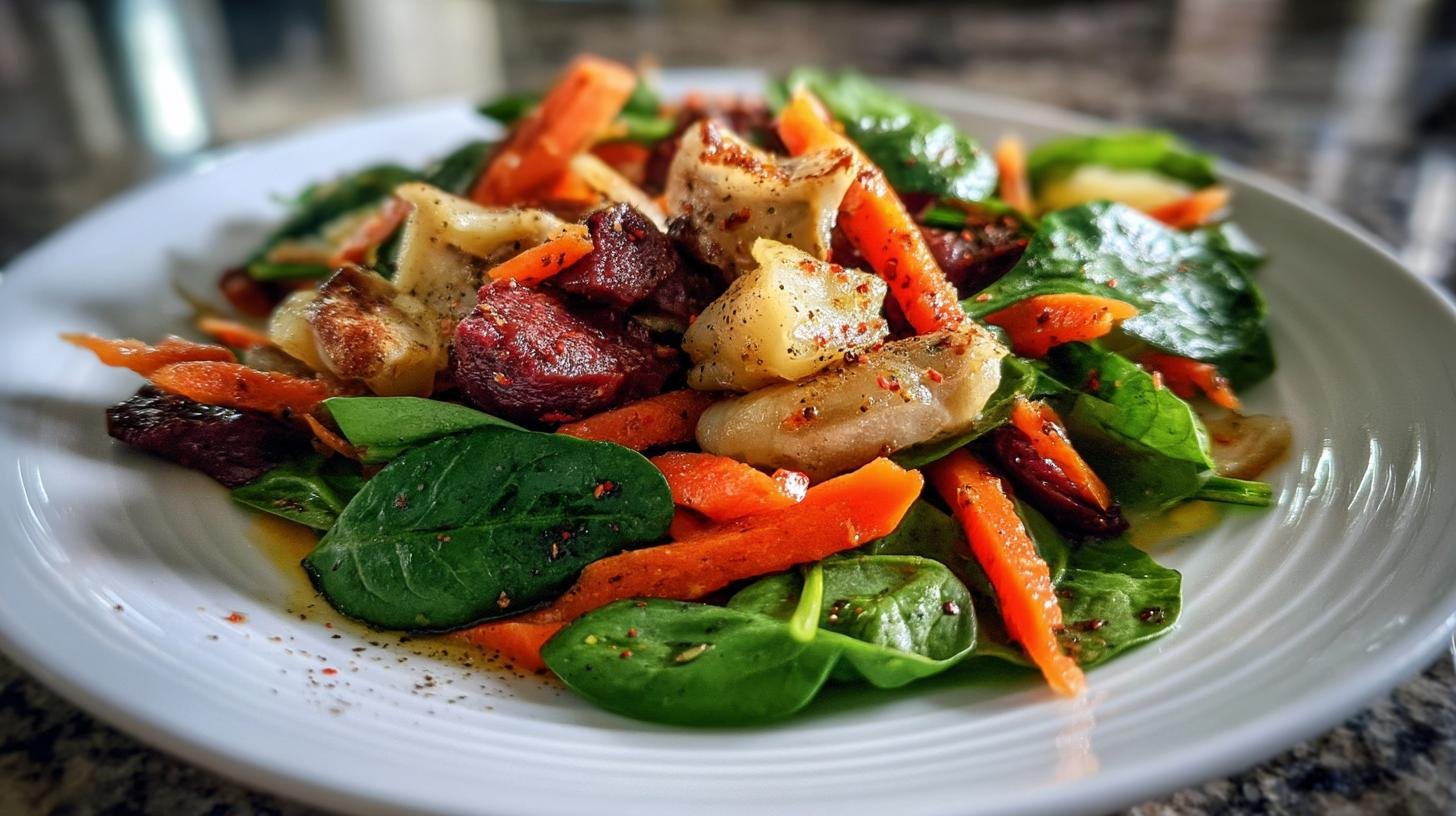When my pup, Scout, started slowing down on our morning walks, I knew something was off. His coat looked dull, he was sluggish after meals, and those once-eager eyes just didn’t shine the same. That’s when I started researching and eventually made the leap into transitioning to raw dog food. Let me tell you — total game changer.
I’ve been feeding raw for over three years now, and I’ve seen firsthand how it can boost energy, improve digestion, and bring back that glossy, healthy coat. It’s not just about tossing raw meat in a bowl — it’s about creating a balanced, natural diet that supports your dog’s whole body health. I’m not a vet (just a very determined dog mom), but I’ve learned a lot through trial, error, and a ton of reading. If you’re curious or ready to take the plunge, I’m here to walk you through it, messes and all.
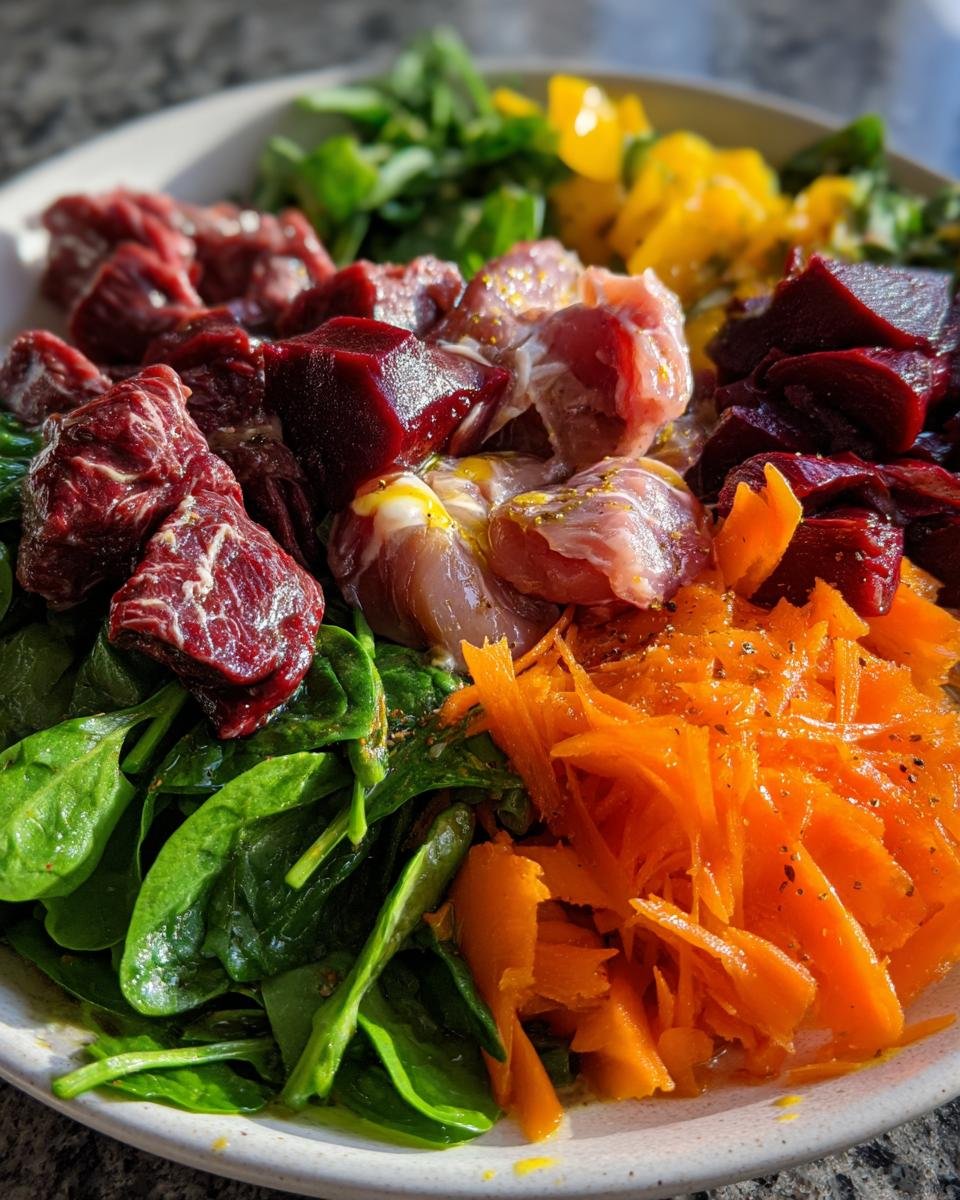
Why Transitioning to Raw Dog Food Can Benefit Your Pet
One of the first things I noticed after switching Scout to raw food was how quickly his digestion improved — no more gurgly stomach or surprise messes in the yard. Raw feeding mimics what dogs would naturally eat in the wild, so their bodies just *get it*. You’ll often see firmer stools, less gas, and better nutrient absorption within the first couple weeks.
His coat? Way shinier. Like, strangers-at-the-dog-park shiny. Raw diets are packed with natural fats and oils that help nourish skin and fur from the inside out. And the energy boost? Huge. Raw-fed dogs tend to act more alert, playful, even puppy-like again. It’s not a magic cure for everything, but for many dogs, transitioning to raw dog food truly brings out their healthiest, happiest selves.
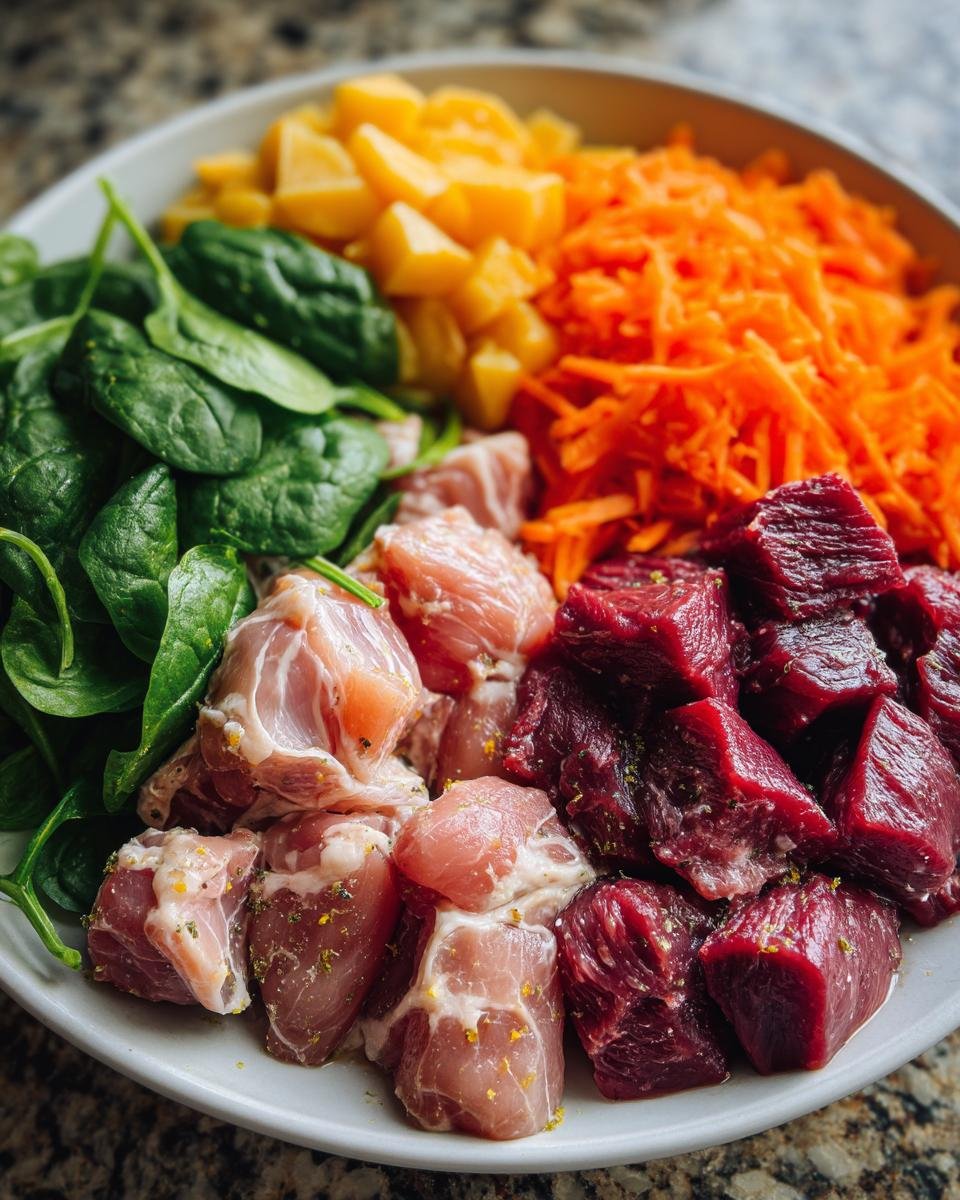
Ingredients for Transitioning to Raw Dog Food
When I started making Scout’s meals from scratch, I quickly learned that quality matters — like, a lot. You’re building your dog’s nutrition from the ground up, so every ingredient has to earn its place in the bowl. I stick to whole, fresh, unprocessed ingredients I’d feel good feeding myself (minus the raw liver — that’s all him!).
Here’s what I use in this base recipe:
- 2 lbs raw chicken (bone-in, skin-on) – I usually go for drumsticks or thighs. The bones provide calcium, and the skin adds healthy fat.
- 1 lb beef liver – This is your vitamin powerhouse. Just make sure it’s fresh and from a good source. I chop it into small pieces for easy mixing.
- 1 cup chopped carrots – Raw and finely chopped or shredded. They add fiber and a bit of natural sweetness.
- 1/2 cup fresh spinach – Washed and chopped. Packed with iron and antioxidants.
- 1 tbsp fish oil – I drizzle this in for omega-3s. It helps with joint health and makes coats extra glossy.
- 1 tsp ground eggshells – A natural calcium source if you’re not using enough bone. I save and dry shells, then grind them to a fine powder.
Always use high-quality, human-grade ingredients and handle them with care — your pup deserves the best fuel you can give!
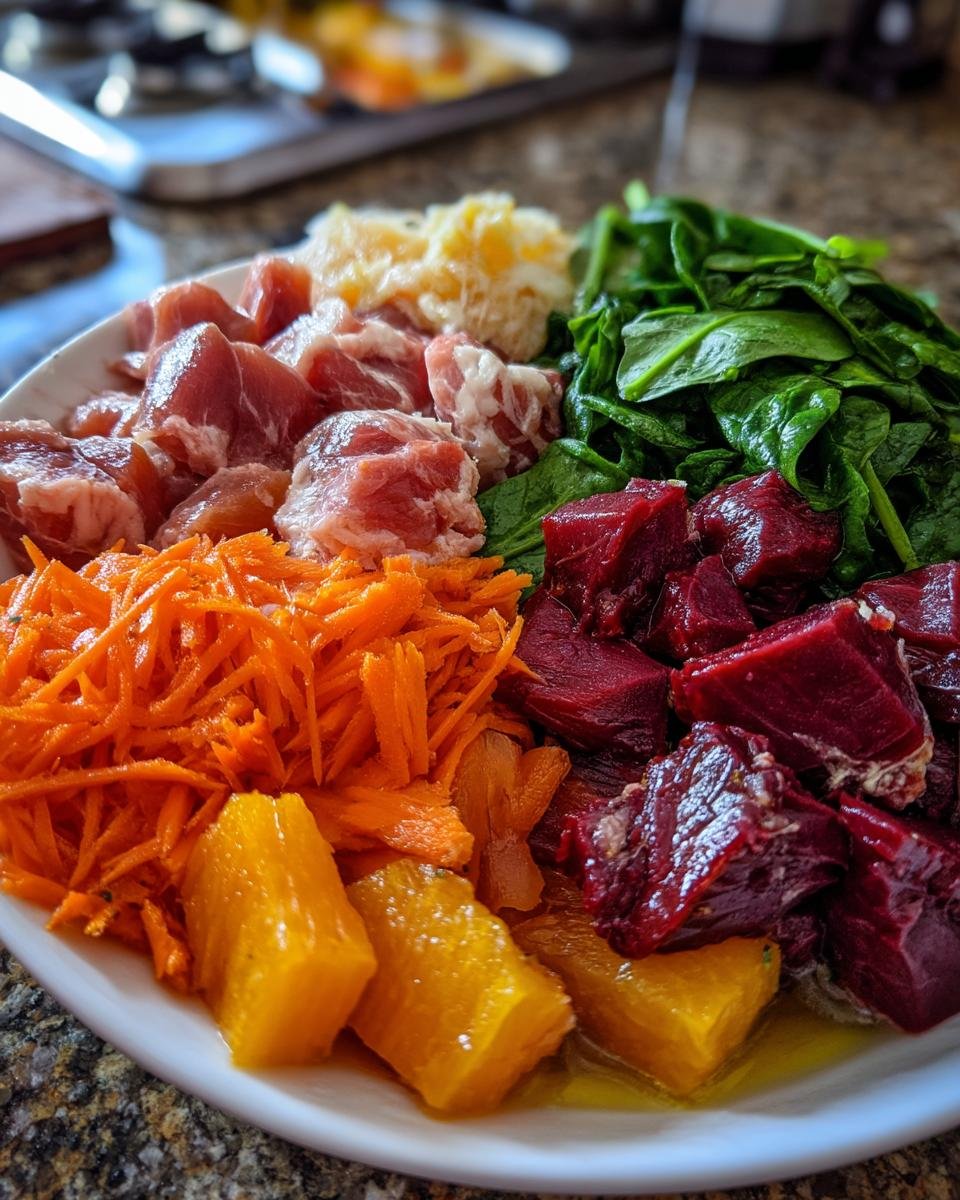
How to Prepare Raw Dog Food for a Smooth Transition
Okay, deep breath — the switch to raw doesn’t have to be overwhelming. The key is easing your dog into it slowly so their tummy doesn’t freak out. I always start by prepping a big batch of raw food (like the recipe above) and freezing it in portioned containers. That way, I’ve got meals ready to go and no scrambling at dinner time.
Here’s how I do the transition:
- Days 1–3: Mix 25% raw food with 75% current food (usually kibble or canned). Just enough to introduce those new proteins and fats without shocking their system.
- Days 4–7: Go to a 50/50 split. This is when you might notice changes — firmer poops, more energy, maybe a little detox breath (totally normal!).
- Days 8–10: Bump it up to 100% raw. You did it! Keep meals consistent and watch how your pup thrives.
Raw food should always be stored in airtight containers in the freezer. I thaw out a meal the night before in the fridge — never on the counter. It keeps it safe and fresh. Once thawed, use it within 2–3 days. If it smells off, toss it. Your dog’s health is worth being extra cautious.
Portion Guidelines by Dog Size
A good rule of thumb is to feed about 2–3% of your dog’s body weight per day. So a 50-pound dog might need around 1 to 1.5 pounds of food daily. Super active pups may need more, couch potatoes a bit less. I always recommend checking with your vet or a canine nutritionist to fine-tune your dog’s portions.
Safe Handling Tips
Raw meat means raw germs — so treat it like you would handling chicken for your own dinner. Always wash your hands before and after prepping, clean surfaces and bowls with hot, soapy water, and keep raw food away from your other groceries. I use a separate cutting board just for Scout’s meals. And never refreeze raw food once it’s thawed. Safety first, tail wags later!
Tips for Success When Transitioning to Raw Dog Food
Here’s what I’ve learned the hard way (so you don’t have to): consistency and patience are your best friends during this switch. Don’t rush it — your pup’s digestive system needs time to adjust. One big tip? Rotate protein sources weekly. Scout does great on chicken, turkey, and beef, but variety keeps things balanced and exciting.
Never feed cooked bones — they can splinter and seriously harm your dog. Raw bones are safe when sized appropriately and supervised. Keep an eye on your dog’s poop (yep, I said it!). Firm, well-formed stools usually mean things are going smoothly. Runny or chalky? Time to tweak the mix or slow down the transition.
Every dog reacts a little differently, so don’t stress if it takes a couple weeks to find your rhythm. Stick with it — your dog’s shiny coat and happy wiggles will totally be worth it.
Ingredient Notes and Substitutions
Each ingredient in this recipe has a job to do, and trust me, it’s not just about flavor — it’s about nourishing your pup from snout to tail. Beef liver is packed with essential vitamins like A and B12, but don’t overdo it — a little goes a long way. Fish oil adds omega-3s for skin, joints, and brain health. If your dog turns up their nose at it, sardine oil is a great swap with similar benefits.
Spinach gives a nice boost of iron and fiber, but if it’s not in your fridge, go for kale or even chopped parsley. Just avoid onions — they’re toxic to dogs. And if you’re not using bone-in chicken, ground eggshells step in as a natural calcium source. It’s all about balance and making sure every bite counts toward your dog’s health.
Frequently Asked Questions About Transitioning to Raw Dog Food
Can I feed only chicken and liver to my dog?
Short answer — nope! While chicken and liver are a great start, raw feeding needs variety to be balanced. Too much liver can cause vitamin A toxicity, and only feeding one protein source can lead to deficiencies. Rotate in other meats like beef, turkey, or lamb and include organs, bones, and a few safe veggies for a complete canine nutrition plan.
How do I know if my dog is reacting well to raw food?
Watch for the happy signs: firmer stools, more energy, shinier coat, and even better breath. Some dogs go through a short “detox” period at first (think mild gas or soft poops), but that should pass quickly. If your pup seems off for more than a few days, it’s a good idea to check in with your vet.
What if my dog refuses to eat raw food?
Don’t panic — some dogs need a little convincing. Try warming the food slightly (not cooking it!) by letting it sit at room temp for a few minutes. You can also sprinkle some bone broth or a bit of their old homemade dog food on top to ease the transition. Patience works wonders here.
Is it okay to mix raw and kibble?
This one’s a bit debated in the raw feeding world. Some dogs do fine with a mix, others may have digestive issues. If you go this route, feed them in separate meals — kibble in the morning, raw at night — to help avoid stomach upset. Always monitor how your dog reacts and adjust as needed.
Storage and Reheating for Raw Dog Food
Once you’ve made a batch of raw dog food, storage is your best friend. I portion everything into airtight containers or freezer-safe bags — usually enough for one or two meals per container. Then I pop them in the freezer so they stay fresh and safe. When I need one, I just pull it out the night before and let it thaw in the fridge. Easy peasy.
Raw food should stay good in the fridge for about 2 to 3 days max. In the freezer, it’ll last up to 3 months if properly sealed. And here’s the biggie: don’t reheat raw food. Cooking it changes the nutrients and bones in ways that can make them unsafe. Serve it cool or at room temp — Scout actually prefers it that way!
Nutritional Information
Here’s the breakdown for a 1-cup serving of this raw dog food recipe — keep in mind, these are just estimates and can vary depending on the exact cuts of meat and veggies you use:
- Calories: 350
- Protein: 28g
- Fat: 22g (with 6g saturated and 14g unsaturated)
- Carbohydrates: 8g
- Fiber: 1.5g
- Cholesterol: 90mg
- Sodium: 120mg
- Sugar: 2g
- Trans Fat: 0g
I always use this info as a general guide, not a strict rule — your pup’s portion needs might be totally different based on size, age, and activity. If you’re ever unsure, a quick chat with your vet or a canine nutritionist can help you dial it in.
What to Do Next
I’d love to hear how your raw feeding journey is going! Drop a comment below if you’ve tried this recipe, have questions, or just want to share your pup’s progress — every dog is different, and we all learn from each other. If you found this helpful, go ahead and rate the recipe or share it with a fellow dog parent who’s thinking about making the switch. Here’s to happier, healthier tails!
Print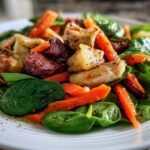
transitioning to raw dog food: 3 Shocking Benefits I Saw Fast
- Total Time: 20 minutes
- Yield: 10–12 servings 1x
- Diet: Gluten Free
Description
Switching your dog to a raw food diet can improve digestion, energy levels, and coat health. Start gradually to avoid stomach upset and ensure balanced nutrition.
Ingredients
- 2 lbs raw chicken (bone-in, skin-on)
- 1 lb beef liver
- 1 cup chopped carrots
- 1/2 cup spinach
- 1 tbsp fish oil
- 1 tsp ground eggshells
Instructions
- Consult your veterinarian to confirm a raw diet suits your dog’s health needs.
- Mix 25% raw food with 75% current diet for 3 days.
- Increase raw food to 50% for the next 4 days.
- Transition to 100% raw food by day 10.
- Serve portions based on your dog’s weight and activity level.
- Store unused raw food in airtight containers in the freezer.
Notes
- Never feed cooked bones—they can splinter.
- Rotate protein sources weekly for nutrient variety.
- Thaw frozen raw food in the fridge overnight.
- Prep Time: 20 minutes
- Cook Time: 0 minutes
- Category: Dog Food
- Method: Raw Feeding
- Cuisine: Pet Food
Nutrition
- Serving Size: 1 cup
- Calories: 350
- Sugar: 2g
- Sodium: 120mg
- Fat: 22g
- Saturated Fat: 6g
- Unsaturated Fat: 14g
- Trans Fat: 0g
- Carbohydrates: 8g
- Fiber: 1.5g
- Protein: 28g
- Cholesterol: 90mg

